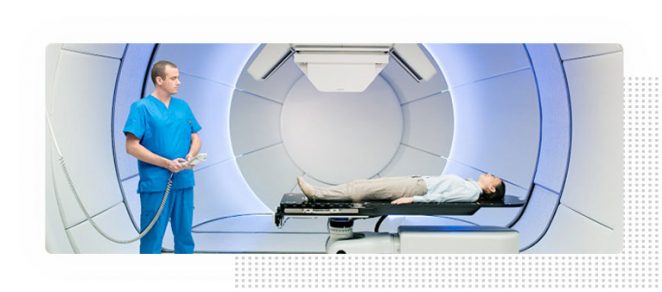The History of Proton therapy
Physicist Robert Wilson thought of using proton instead of traditional photon (X-Ray) around 1946 hoping to minimize the bad side effect of radiation that which may insult healthy organs. The research work developed gradually till Wilson developed the 1st a research accelerator at Harvard University. It took very long time to make this technology available to treat patients because of heavy financial burden to build and operate such mega device. Proton Therapy gained the acceptance from radiation oncologist after the publications of thousands of peer reviewed scientific researches and it became one of the main modalities in treating cancer at many countries were hundred thousands of patients were treated with perfect treatment outcomes.
The Used Techniques
The Saudi Proton Therapy Center is divided into 4 major operational units:
1. Totally automated patients treatment rooms
2. Complete Rotating Gantry in all direction around the patient. That minimizing the need to reposition the patient. .
3. Proton Beam transportation system that focuses and shapes the beam and guides it to the treatment room,
4. Cyclotron which is superconducting device uses electromagnetic waves to accelerate proton beams.

FAQ
Proton radiotherapy in principles could treat any type of cancer responding to radiotherapy but it was limited to certain indication if it’s possible to treat the same cancer with another less expensive modality while the side effect is similar.
Scientific studies have demonstrated that in certain types of cancer the side effect of radiotherapy is unacceptable because of the undesired effect on the normal tissues around the cancer spot such as tumors of children, eyes, brain, prostate and any tumors near organs sensitive to radiation where they found that Proton therapy has an unmatched benefit.
Proton therapy is superior to all other techniques currently available for radiotherapy, but its high cost remains a major obstacle to many countries to have this technology.
Its Saudi FDA, FDA, Japan, EU, Korea, and CE approved treatment.
Proton therapy limits irradiating healthy organs surrounding the tumor or on its way and this will lead to fewer side effects.
Protons produce the highest dose of treatment in the center of the tumor to over kill the malignant cells while minimizing the dose outside the tumor to maximize the safety.
It’s known in radiotherapy that higher dose is beneficial in certain types of cancer but it was not practiced because of major unacceptable side effects, Proton could optimize the high dose to control cancer while saving the normal structure around the tumor.
This treatment reduces the common complications of traditional radiotherapy while maintaining the efficacy and safety.
Proton therapy is limited to damage the healthy organs located within the beam of treatment in front of the tumor area, as well as it is limited to damage the organs behind or next to it. The protons also stop within the tumor, producing a high dose of treatment only in the tumor area. Based on the above, it is possible to give the patient high doses without affecting the organs surrounding the tumor area, which causes the increase of recovery rate. The studies have proven that there is a correlation between the given dose and the possibility of its control.
Treated Cases

Proton therapy is useful for cancer patients in its early stages, and it is also effective in the treatment of tumors near sensitive organs.
Radiation oncologist (physician specialized in treating cancer by radiation) will advise the patient and his/her family about the best modality to be used.
In general proton technology: is useful in treating the following types of cancer:
Child Cancer
Eye Cancer
Head and Neck Cancer
Brain Cancer
Prostate Cancer
Spinal Cancer
The Status during Treatment
Before attending the first consultation session, the patient must submit all the medical documents and images to evaluate the medical condition of the patients and the suitability of treatment to the disease. After reviewing the case, the patient will be contacted to determine the date of the first appointment.
Our trained coordinators will take care of this process.
On the first consultation day, the patient must be available 15 minutes prior to the appointment time at the front reception.
Our team will welcome the patient and coordinate with the medical team to be notified about the patient's presence.
Proton Radiotherapy nurse will meet the patient for initial assessment, and prepare other necessary treatment records before you see our consultant and his medical team.
The consultant and his team will review all documents, interview the patient and formulate the treatment plan which they going to explain in details for the patient and or his family and they will answer any questions arise, the patient have the right to reject the plan if he want, once the patient and /or his guardian/family agreed to have the treatment course they will be asked to sign the therapy consent. The patient's approval to the treatment plan proposed by the center is mandatory.
The consultant team will book the dates of the simulation (pre therapy scan) and therapeutic sessions date according to the consultant instructions.
Because our center goal is to comfort patients we welcome a family member/s or friend to the consultation room.
All our staff is trained to serve the patients to make this period of cancer treatment something to remember with a smile.
The duration of treatment is variable according to the diagnosis and to the radiotherapy treatment plan recommended by the treating consultant. Treatment may take up to 6 weeks for complex cases.
Treatment sessions range from 20 to 30 minutes.
The patient will be given full details of the treatment on the 1st encounter with our consultant.
At the last treatment sessions, the doctor will assess the patient and schedule follow up appointment.

